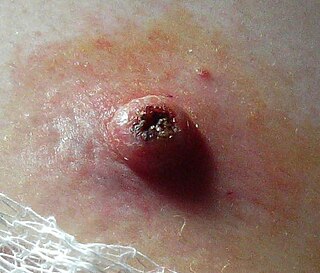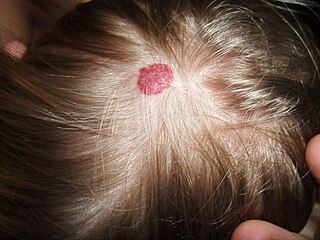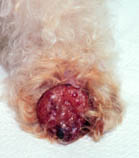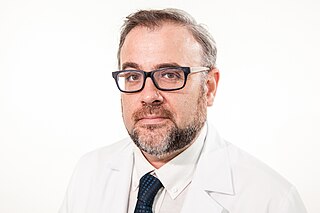
Squamous-cell skin cancer, also known as cutaneous squamous-cell carcinoma (cSCC), is one of the main types of skin cancer along with basal cell cancer, and melanoma. It usually presents as a hard lump with a scaly top but can also form an ulcer. Onset is often over months. Squamous-cell skin cancer is more likely to spread to distant areas than basal cell cancer. When confined to the outermost layer of the skin, a precancerous or in situ form of cSCC is known as Bowen's disease.

Basal-cell carcinoma (BCC), also known as basal-cell cancer, is the most common type of skin cancer. It often appears as a painless raised area of skin, which may be shiny with small blood vessels running over it; or it may present as a raised area with ulceration. Basal-cell cancer grows slowly and can damage the tissue around it but is unlikely to spread to distant areas or to result in death.

Lichen planus is a chronic inflammatory and immune mediated disease that affects the skin, nails, hair, and mucous membranes. It is characterized by polygonal, flat-topped, violaceous papules and plaques with overlying, reticulated, fine white scale, commonly affecting dorsal hands, flexural wrists and forearms, trunk, anterior lower legs and oral mucosa. Although there is a broad clinical range of LP manifestations, the skin and oral cavity remain as the major sites of involvement. The cause is unknown, but it is thought to be the result of an autoimmune process with an unknown initial trigger. There is no cure, but many different medications and procedures have been used in efforts to control the symptoms.

Lichen sclerosus (LS) is a chronic, inflammatory skin disease of unknown cause, commonly appearing as whitish patches on the genitals, which can affect any body part of any person but has a strong preference for the genitals and is also known as balanitis xerotica obliterans (BXO) when it affects the penis. Lichen sclerosus is not contagious. There is a well-documented increase of skin cancer risk in LS, potentially improvable with treatment. LS in adult age is normally incurable, but improvable with treatment, and often gets progressively worse.

Cherry angiomas, also known as Campbell De Morgan spots or senile angiomas, are cherry red papules on the skin. They are a harmless benign tumor, containing an abnormal proliferation of blood vessels, and have no relationship to cancer. They are the most common kind of angioma, and increase with age, occurring in nearly all adults over 30 years.

Actinic keratosis (AK), sometimes called solar keratosis or senile keratosis, is a pre-cancerous area of thick, scaly, or crusty skin. The term actinic keratosis can be literally understood as a disorder (-osis) of epidermal keratinocytes that is induced by ultraviolet (UV) light exposure (actin-). These growths are more common in fair-skinned people and those who are frequently in the sun. They are believed to form when skin gets damaged by UV radiation from the sun or indoor tanning beds, usually over the course of decades. Given their pre-cancerous nature, if left untreated, they may turn into a type of skin cancer called squamous cell carcinoma. Untreated lesions have up to a 20% risk of progression to squamous cell carcinoma, so treatment by a dermatologist is recommended.

Mycosis fungoides, also known as Alibert-Bazin syndrome or granuloma fungoides, is the most common form of cutaneous T-cell lymphoma. It generally affects the skin, but may progress internally over time. Symptoms include rash, tumors, skin lesions, and itchy skin.

Merkel-cell carcinoma (MCC) is a rare and aggressive skin cancer occurring in about 3 per 1,000,000 population. It is also known as cutaneous APUDoma, primary neuroendocrine carcinoma of the skin, primary small cell carcinoma of the skin, and trabecular carcinoma of the skin. Factors involved in the development of MCC include the Merkel cell polyomavirus, a weakened immune system, and exposure to ultraviolet radiation. Merkel-cell carcinoma usually arises on the head, neck, and extremities, as well as on the perianal and eyelid. It is more common in elderly people, people who have a weakened immune system, and people who were exposed to UV radiation. MCC is less common in children.
Polyostotic fibrous dysplasia is a form of fibrous dysplasia affecting more than one bone. Fibrous dysplasia is a disorder where bone is replaced by fibrous tissue, leading to weak bones, uneven growth, and deformity.

Keratoacanthoma (KA) is a common low-grade rapidly-growing skin tumour that is believed to originate from the hair follicle and can resemble squamous cell carcinoma.

Imiquimod (INN) is a prescription medication that acts as an immune response modifier that is used to treat genital warts, superficial basal cell carcinoma, and actinic keratosis. Scientists at 3M's pharmaceuticals division discovered the drug and 3M obtained the first FDA approval in 1997 under the brand Aldara. As of 2015, imiquimod is generic and is available worldwide under many brands.

A vascular tumor is a tumor of vascular origin; a soft tissue growth that can be either benign or malignant, formed from blood vessels or lymph vessels. Examples of vascular tumors include hemangiomas, lymphangiomas, hemangioendotheliomas, Kaposi's sarcomas, angiosarcomas, and hemangioblastomas. An angioma refers to any type of benign vascular tumor.

Necrolytic migratory erythema is a red, blistering rash that spreads across the skin. It particularly affects the skin around the mouth and distal extremities; but may also be found on the lower abdomen, buttocks, perineum, and groin. It is strongly associated with glucagonoma, a glucagon-producing tumor of the pancreas, but is also seen in a number of other conditions including liver disease and intestinal malabsorption.
Psychodermatology is the treatment of skin disorders using psychological and psychiatric techniques by addressing the interaction between mind and skin. Existent statistical evidence does not appear to support these claims.

Amelanotic melanoma is a type of skin cancer in which the cells do not make any melanin. They can be pink, red, purple or of normal skin color, and are therefore difficult to diagnose correctly. They can occur anywhere on the body, just as a typical melanoma can.

Robert Allen Schwartz is an American physician, biomedical researcher, university professor, and government official. He is Professor and Head of Dermatology, Professor of Medicine, Professor of Pediatrics, and Professor of Preventive Medicine and Community Health at the Rutgers New Jersey Medical School, Visiting Professor and Scholar of Public Affairs and Administration at the Rutgers School of Public Affairs and Administration, and serves on the Rutgers University Board of Trustees. He has made seminal contributions to medicine, including the discovery of AIDS-associated Kaposi sarcoma (KS-AIDS) and the Schwartz-Burgess syndrome. In 2019 Schwartz joined the Trump administration as a member of the Presidential Advisory Council on HIV/AIDS.

Kaposi's sarcoma (KS) is a type of cancer that can form masses in the skin, lymph nodes, or other organs. The skin lesions are usually purple in color. They can occur singularly, in a limited area, or be widespread. It may worsen either gradually or quickly. Lesions may be flat or raised. Human herpesvirus 8 (HHV8) is found in the lesions of all those who are affected. Risk factors include poor immune function, either as a result of disease or specific medications, and chronic lymphedema.
David J. Leffell, MD, was born in 1956 in Montreal, Canada and educated at Yale. Leffell is an internationally recognized expert in skin cancer and the Mohs technique, plastic reconstruction, and new technologies in dermatology. He specializes in the diagnosis, treatment, and prevention of melanoma and nonmelanoma skin cancer. He is the David Paige Smith Professor of Dermatology and Surgery, chief of Dermatologic Surgery and Cutaneous Oncology, and former Deputy Dean for Clinical Affairs at Yale University School of Medicine. In January 2012, Dr. Leffell stepped down as chief executive officer of the Yale Medical Group, after 15 years of leadership of the organization. He serves on the board of Validus Pharmaceuticals and is a trustee of The Hopkins School, one of America's oldest independent schools.

Fernando Alfageme Roldán is a Spanish dermatologist. He introduced the diagnostic technique of cutaneous ultrasound in Spain, is an associate professor at the Autonomous University of Madrid, and is responsible for the Dermatological Ultrasound Unit at the Puerta de Hierro University Hospital in Majadahonda. He has authored several essays, manuals and academic articles about dermatology.
Histopathology of dermatitis can be performed in uncertain cases of inflammatory skin condition that remain uncertain after history and physical examination.















